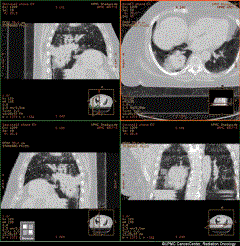What Is a 4D CT Scan?
 4D CT (computed tomography) represents the next step in imaging.
4D CT (computed tomography) represents the next step in imaging.
This advanced imaging method makes CT scans much faster and more accurate than ever before.
4D CT uses a new technology that captures the location and movement of your tumor and the movement of your body’s organs over time.
This is valuable for accurately treating tumors located on or near organs that move, such as those in the chest and abdomen.
What to Expect During a 4D CT Scan
A 4D CT scan is much like a classic CT scan.
During a 4D CT scan:
- You lie very still on your back.
- The scanner spins around you in a corkscrew path, taking constant pictures.
- It takes about 30 seconds for the scanner to complete its path around your body.
The scanner makes a 4D image showing:
- Your body’s breathing.
- How the tumor moves.
- How movement of nearby organs affects the position of your tumor.
What Are the Benefits of 4D CT Scans?
The information from the 4D CT scan allows your radiation oncologist to:
- Design more precise treatments for moving tumors.
- Better target these moving tumors and deliver radiation within a certain interval in the breathing cycle.
- Reduce your risk of treatment-related side effects.
For instance, a tumor on the lung will move with each breath, as the lung inflates and deflates.
With traditional imaging, the oncologist:
- Can only know the position of the tumor at one point in the breath.
- Aims radiation at the tumor during the one point of the breath matching the image. The beam may miss the tumor or damage healthy tissue.
To compensate, the oncologist may use lower, less effective levels of radiation — reducing the effectiveness of the entire treatment.
Precise radiation delivery to tumors, not healthy tissue
Through 4D CT, the radiation oncologist can deliver radiation within a certain interval in the breathing cycle.
He or she does this using gated intensity-modulated radiation therapy (IMRT), where the radiation stops when the tumor isn't in the correct position.
This allows the use of higher, more effective levels of radiation, while minimizing the impact on healthy tissue.
Contact Us About Radiation Oncology at UPMC Hillman Cancer Center
To learn more about radiation treatments or to make an appointment you can:
- Call 412-647-2811
- Contact a UPMC Hillman Cancer Center near you.
 UPMC
UPMC
 UPMC Children's Hospital of Pittsburgh
UPMC Children's Hospital of Pittsburgh
 UPMC Magee-Womens Hospital
UPMC Magee-Womens Hospital
 UPMC Immune Transplant and Therapy Center
UPMC Immune Transplant and Therapy Center

